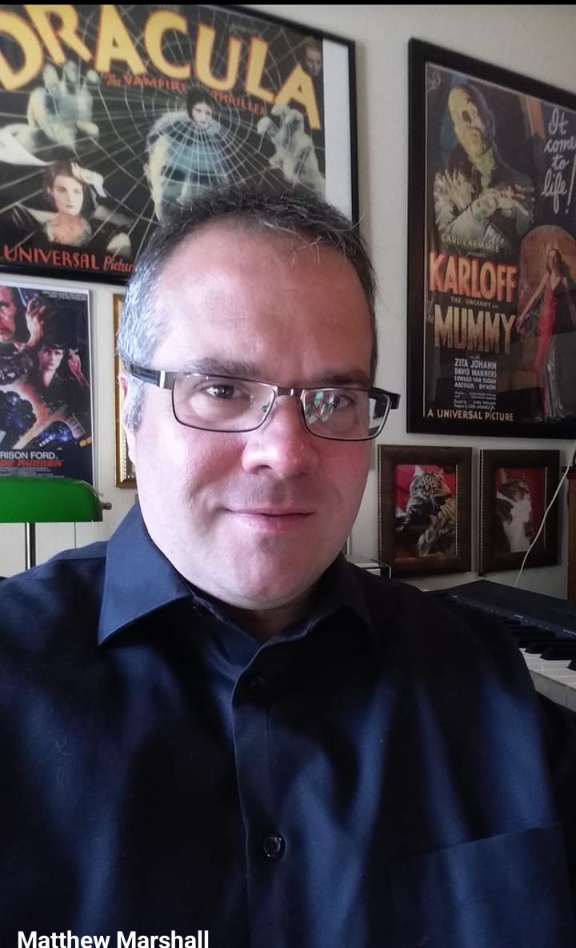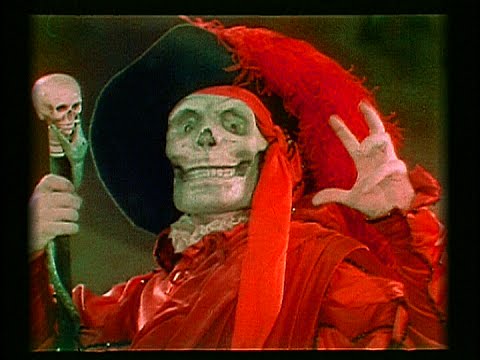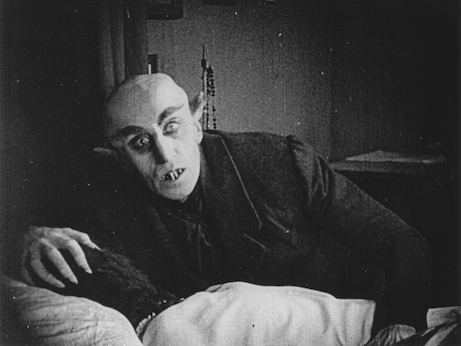The Sounds of Silent Film

Composer, screenwriter, and adjunct film lecturer Matthew Marshall in the Department of Media Studies in the College and Graduate School of Arts & Sciences at the University of Virginia once again treats readers with a Halloween blog. Read along as Marshall teaches us about the history of silent films and shares upcoming local events.
On Sunday, October 30th, Charlottesville moviegoers will get a chance to walk through a time portal and experience film, the way it was done over 100 years ago- movie images projected while live music is performed. UVA Film History lecturer and composer, Matt Marshall will be accompanying the 1925 classic silent horror film, Phantom of the Opera (1925) on the keyboard, along with his Reel Music Trio, which includes Elizabeth Hilles on violin, Bob Ducharme on viola and Madaline Marland on bass clarinet. Most only know of the Andrew Lloyd Webber musical but Phantom was a Horror Melodrama for much longer than it has been a musical. It is an adaptation of the 1911 Gaston Leroux novel of the same name and stars silent screen and makeup legend, Lon Chaney. The music will be based on the original music cue sheets.
For the first 30 years of cinema history, films were shown without sound, but audiences never sat in silence. Movie exhibitors knew early on that these visual narratives needed musical accompaniment for dramatic support. Live music had been a part of live stage drama going back to Ancient Greece. It followed that these modern photo plays should have music as well. In addition, early movie projectors were loud. Live music helped cover the distracting sounds of the click-click-click, as film flickered through the mechanism.

I fell in love with silent films when I was around 12 years old. I saw actor Lon Chaney Sr - “the Man of 1,000 Faces”—in a PBS broadcast of Phantom of the Opera (1925). There was such a unique beauty to the way he moved and expressed himself within the elaborate sets created by Universal Studios. It was a mix of dance, sculpture, pantomime, and poetry. I was hooked and felt the call to make music for these classic picture shows.
My first gig was at the Virginia Film Festival in 2001. It was the craziest occurrence. That year, the Film Festival’s theme was, Masquerades, and they needed someone to perform live keyboard music for Phantom of the Opera. I bumped into then-director Richard Herskowitz, and he said, “Oh, you do that? I need you.” I was in the right place at the right time. No coincidences. In 2006, I created the Reel Music Ensemble, which usually consists of three or four orchestral players from the Charlottesville community and students from the UVA Music department. We rotate players from event to event. I used to write all original music but in the last five years, there have been great advances in online access to digital music archives, where one can find the original cue sheets. It is easier to find what was played at the time of the film’s release and as a teacher of Film History, I want to give the audience a closer sense of what they would have heard in the 1920s.

We are once again in the era of the 20s, the 2020s. Over the next 7 years, we will be celebrating the 100th anniversary of the most famous films of the 1920s silent era, films such as The Hunchback of Notre Dame, The Thief of Bagdad, The Phantom of the Opera, Charlie Chaplin’s The Gold Rush, Buster Keaton’s The General, and Fritz Lang’s Metropolis. This year, the famous German Dracula adaptation, Nosferatu (1922) by F.W. Murnau, turns 100.

As the adage goes, "Everything old is new again." These silent film events are a unique opportunity for new audiences to slow down, take a break from our fast-paced culture, and appreciate film when it was more of a performing art.
Matt Marshall and The Reel Music trio will be accompanying Phantom of the Opera Sunday, Oct 30, at 2 p.m. at The Paramount Theater. Additionally, they will perform F.W. Murnau’s Dracula adaptation, Nosferatu (1922) at Vinegar Hill Theater/ Lighthouse Studios, for the 35th Virginia Film Festival, Thursday, Nov 3, 8 p.m.
Phantom of the Opera Event: Sunday, Oct, 30, 2 p.m.:
https://www.theparamount.net/event/the-phantom-of-the-opera/
Nosferatu 100th Anniversary Event, Virginia Film Festival: Thursday, Nov 3, 8 p.m.:
https://virginiafilmfestival.org/films/nosferatu/
SILENT FILM MUSIC HISTORY EXTRAS
In the Silent Era, Film studios had music directors who were in charge of compiling appropriate music that could cover the proper moods of each scene of a film. A cue sheet would be created. This sheet had about 50 short scene descriptions, along with the name of the piece of music recommended to be played along with that scene. Movie studios sent cue sheets out to theaters along with the films, and theaters hired musicians to play along. In smaller theaters, just a solo piano or organist played along, but in larger cities sometimes chamber groups, bands, and orchestras accompanied the film screenings.
In the way Jazz musicians use “The Real Book,” an A-Z anthology of standards and popular songs, silent film musicians had their own compilation books, such as Motion Picture Moods by Erno Rappe. This book includes piano music for 52 moods, themes, and situations. In the margins of each page is a list of descriptive words, such as chase, romance, fire-fighter, horses, mystery, and battle. The pianist or organist could look up at the screen and flip to the appropriate page when the mood of the scene changed. Each of these 52 moods had approximately 5 pieces of music that could be played and would work to fit the scene. It was not ideal, but it is how film scoring began.

- Life at the Top: Climate Change in Utqiaġvik, Alaska
- The Only Thing We Have to Fear is Fear Itself
- Stay on Track: Turning Resolutions into Results
- Men's ACC Basketball Tournament: UVA Fan Events
- UVA Club of Tidewater: Hoos at Harbor Park
- UVA Club of Atlanta: Cavs Care - Volunteer Income Tax Assistance Events